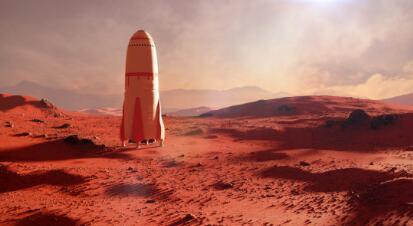Will it be safe for humans to fly to Mars?
人类飞向火星安全吗?

credit:© dottedyeti / stock.adobe.com
Sending human travelers to Mars would require scientists and engineers to overcome a range of technological and safety obstacles. One of them is the grave risk posed by particle radiation from the sun, distant stars and galaxies.
将人类旅行者送往火星可能需要科学家和工程师们克服一系列技术和安全方面的难题。其中一个难题就是阳光、遥远星球和银河系所产生的粒子辐射所带来的严重风险。
particle radiation:粒子辐射
Answering two key questions would go a long way toward overcoming that hurdle: Would particle radiation pose too grave a threat to human life throughout a round trip to the red planet? And, could the very timing of a mission to Mars help shield astronauts and the spacecraft from the radiation?
回答两个关键问题也许对克服这一障碍大有助益:粒子辐射会对往返火星的人类生命造成严重威胁吗?还有,前往火星的时机能否使宇航员和宇宙飞船免于辐射?
Spacecraft:宇宙飞船
go a long way toward:大有助益,对……有帮助
In a new article published in the peer-reviewed journal Space Weather, an international team of space scientists, including researchers from UCLA, answers those two questions with a "no" and a "yes."
在一篇发表于经过同行评审的期刊-《空间气象》的新文章中,一个由太空科学家,包括来自于加州大学洛杉矶分校的研究人员组成的团队用“否”和“是”对这两个问题进行了回答。
peer-reviewed:同行评审
That is, humans should be able to safely travel to and from Mars, provided that the spacecraft has sufficient shielding and the round trip is shorter than approximately four years. And the timing of a human mission to Mars would indeed make a difference: The scientists determined that the best time for a flight to leave Earth would be when solar activity is at its peak, known as the solar maximum.
也就是说,如果宇宙飞船有足够的防护并且往返旅行不超过大约4年的话,人类应该可以安全地往返于火星。而人类前往火星的时机确实很重要:科学家们认为离开地球,飞向火星的最佳时机应该是太阳活动性处于高峰期,也就是太阳活动极大期。
That is:就是说,即,用于解释之前说过的内容
solar activity:太阳活动性
solar maximum:太阳活动极大期
The scientists' calculations demonstrate that it would be possible to shield a Mars-bound spacecraft from energetic particles from the sun because, during solar maximum, the most dangerous and energetic particles from distant galaxies are deflected by the enhanced solar activity.
科学家们的计算显示,这时出发可能会使前往火星的宇宙飞船避免来自太阳的能量粒子。这是因为,在太阳活动极大期,来自遥远星系最危险且最具能量的粒子能够被增强的太阳活性所转移。
Deflect:转移、引开
A trip of that length would be conceivable. The average flight to Mars takes about nine months, so depending on the timing of launch and available fuel, it is plausible that a human mission could reach the planet and return to Earth in less than two years, according to Yuri Shprits, a UCLA research geophysicist and co-author of the paper.
特定时间的旅行是可以想象得到的。前往火星的平均飞行时间大约为9个月,因此,根据Yuri Shprits,加州大学洛杉矶分校地球物理研究者和论文的共同作者的介绍,根据发射的时间和可用的燃料,人类可以在不到2年的时间里前往火星,然后再返回地球。
"This study shows that while space radiation imposes strict limitations on how heavy the spacecraft can be and the time of launch, and it presents technological difficulties for human missions to Mars, such a mission is viable," said Shprits, who also is head of space physics and space weather at GFZ Research Centre for Geosciences in Potsdam, Germany.
“这项研究表明,尽管太阳辐射对宇宙飞船的重量和发射时间有非常严格的限制,而且还给人类前往火星完成任务提出了技术难题,但是任务还是可以实施的,”Shprits表示。Shprits同时也是德国波茨坦地球科学GFZ研究中心太空物理学和太空气象部的主任。
Viable:可实施的、切实可行的
The researchers recommend a mission not longer than four years because a longer journey would expose astronauts to a dangerously high amount of radiation during the round trip -- even assuming they went when it was relatively safer than at other times. They also report that the main danger to such a flight would be particles from outside of our solar system.
研究人员建议飞行任务不超过4年,这是因为飞行时长超过4年后,会使宇航员在往返飞行时暴露在危险的、高剂量的辐射下-即使假设他们出发的时间比其他时间相对更加安全。他们还报告说,飞行的主要危险也许是来自太阳系以外的粒子。
Shprits and colleagues from UCLA, MIT, Moscow's Skolkovo Institute of Science and Technology and GFZ Potsdam combined geophysical models of particle radiation for a solar cycle with models for how radiation would affect both human passengers -- including its varying effects on different bodily organs -- and a spacecraft. The modeling determined that having a spacecraft's shell built out of a relatively thick material could help protect astronauts from radiation, but that if the shielding is too thick, it could actually increase the amount of secondary radiation to which they are exposed.
Shprits和加州大学洛杉矶分校、麻省理工学院、莫斯科斯科尔科沃科技研究所和GFZ波茨坦的同事们将太阳周期粒子辐射的地球物理模型和辐射如何影响人类乘客(包括辐射对不同人体部位所产生的不同影响)和宇宙飞船的模型相结合。通过结合模型发现,宇宙飞船的外壳采用相对较厚的材料可以帮助宇航员免于辐射,但是如果防护外壳过厚,可能会使次级辐射的量有所增加。
solar cycle:太阳周期、太阳活动周期
secondary radiation:次级辐射、二次辐射
The two main types of hazardous radiation in space are solar energetic particles and galactic cosmic rays; the intensity of each depends on solar activity. Galactic cosmic ray activity is lowest within the six to 12 months after the peak of solar activity, while solar energetic particles' intensity is greatest during solar maximum, Shprits said.
太空中的两大有害辐射类型为太阳能粒子和银河宇宙射线;每种辐射的强度都取决于太阳活性。银河宇宙射线的活性在太阳火星高峰期后6-12个月内处于最低状态,而太阳能粒子的强度则在太阳极大期处于最高峰值,Shprits表示。
来源:科学日报 翻译&编辑:译锐翻译Susan
